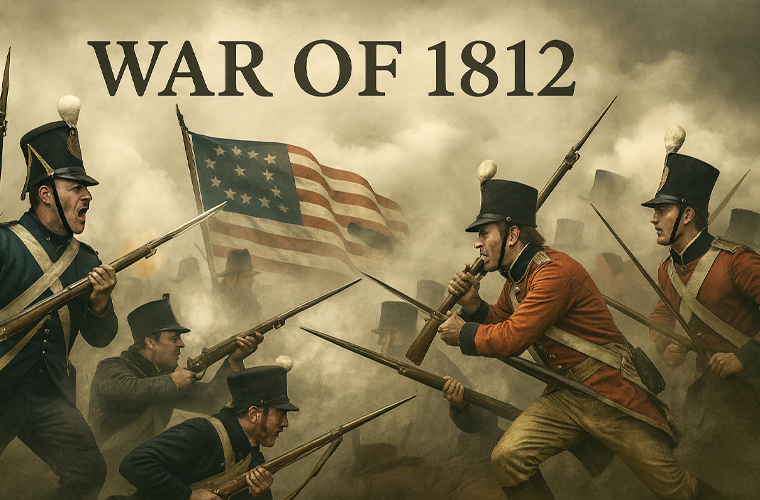A Conflict of Independence and Identity
The War of 1812, often called the “Second War of Independence,” was a pivotal conflict between the United States and Great Britain from June 18, 1812, to February 17, 1815. Fought just decades after the American Revolution, this war shaped the young nation’s identity, solidified its sovereignty, and influenced North American geopolitics. While it ended without a clear victor, the war had lasting impacts on the United States, Canada, and Native American tribes.
Causes of the War
Several grievances fueled the United States’ declaration of war against Britain:
- Impressment of American Sailors: Britain’s Royal Navy, engaged in a prolonged conflict with Napoleonic France, frequently seized American sailors and forced them into service, claiming they were British deserters. This violation of American sovereignty enraged the public and government.
- Trade Restrictions: Britain’s Orders in Council restricted American trade with Europe, particularly France, as part of its economic warfare against Napoleon. These restrictions crippled American commerce, especially in New England.
- Territorial Ambitions: Many Americans, particularly “War Hawks” in Congress, coveted British-controlled Canada. They saw the war as an opportunity to expand U.S. territory northward.
- Native American Conflicts: The British supported Native American tribes in the Northwest Territory, who resisted American expansion. Americans believed Britain was arming tribes to destabilize the frontier.
These issues, combined with a surge of American nationalism, prompted President James Madison to request a declaration of war, which Congress approved in June 1812.
Major Events and Campaigns
The War of 1812 unfolded across multiple theaters, including land battles in North America, naval engagements on the Great Lakes and Atlantic, and significant campaigns involving Native American tribes.
Early American Offensives (1812)
The United States launched invasions of Canada, expecting an easy victory. However, poor planning and inexperienced militia led to failures:
- Invasion of Canada: General William Hull’s attempt to capture Upper Canada (modern Ontario) failed, culminating in the surrender of Detroit to British forces and their Native allies under Tecumseh.
- Battle of Queenston Heights: An American attempt to invade Canada across the Niagara River was repelled, though it resulted in the death of British General Isaac Brock, a significant loss for the British.
Naval Successes and the Great Lakes (1812–1813)
Despite being outnumbered, the U.S. Navy achieved surprising victories:
- USS Constitution vs. HMS Guerrière: In August 1812, the USS Constitution, nicknamed “Old Ironsides,” defeated the British frigate HMS Guerrière, boosting American morale.
- Battle of Lake Erie (1813): Commodore Oliver Hazard Perry’s victory over the British fleet on Lake Erie secured American control of the Great Lakes, enabling successful campaigns in the Northwest.
Turning Points and British Counterattacks (1814)
As the Napoleonic Wars ended in 1814, Britain redirected resources to North America:
- Burning of Washington, D.C.: In August 1814, British forces captured and burned Washington, D.C., including the White House and Capitol, in retaliation for American attacks on Canadian cities like York (modern Toronto).
- Battle of Baltimore: American forces successfully defended Fort McHenry, inspiring Francis Scott Key to write “The Star-Spangled Banner.” The British failed to capture Baltimore, a significant setback.
- Battle of Plattsburgh: A combined American land and naval victory on Lake Champlain halted a major British invasion from Canada.
The Southern Theater and Native American Involvement
The war significantly impacted Native American tribes, particularly in the South and Northwest:
- Creek War (1813–1814): A faction of the Creek Nation, the Red Sticks, allied with the British and fought against American forces. Andrew Jackson’s victory at the Battle of Horseshoe Bend in 1814 crushed Creek resistance, leading to significant land cessions.
- Tecumseh’s Confederacy: Shawnee leader Tecumseh, allied with the British, sought to unite tribes against American expansion. His death at the Battle of the Thames in 1813 weakened Native resistance in the Northwest.
The Treaty of Ghent and the Battle of New Orleans
The war concluded with the Treaty of Ghent, signed on December 24, 1814, which restored pre-war boundaries but resolved few of the underlying issues. Due to slow communication, the Battle of New Orleans occurred on January 8, 1815, after the treaty was signed. Andrew Jackson’s decisive victory over British forces became a symbol of American resilience and propelled Jackson to national fame.
Consequences and Legacy
The War of 1812 had profound effects on the United States, Canada, and Native American tribes:
- American Nationalism: The war fostered a sense of national identity. The defense of Fort McHenry and the victory at New Orleans boosted American pride and unity.
- Canadian Identity: British and Canadian forces, alongside Native allies, repelled American invasions, laying the foundation for Canadian nationalism and a distinct identity separate from the United States.
- Native American Losses: The war devastated Native American tribes, particularly in the Northwest and South. The deaths of leaders like Tecumseh and the loss of British support weakened their ability to resist American expansion.
- Economic and Political Shifts: The war exposed American military weaknesses, leading to reforms and the eventual establishment of a stronger standing army. It also accelerated industrialization, as trade disruptions forced reliance on domestic manufacturing.
- No Clear Victor: The Treaty of Ghent resolved little, but the war ended Britain’s impressment practices and eased trade tensions, as the Napoleonic Wars had concluded.
The War of 1812 was a complex conflict driven by issues of sovereignty, trade, and territorial ambition. While it ended in a stalemate, it profoundly shaped the United States and Canada, strengthening their national identities and altering the trajectory of Native American history. Often overshadowed by larger wars, the War of 1812 remains a critical chapter in North American history, highlighting the challenges and resilience of a young nation asserting its place on the world stage.

